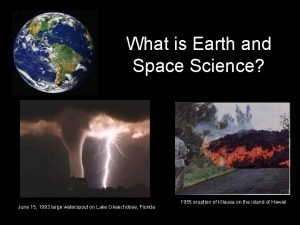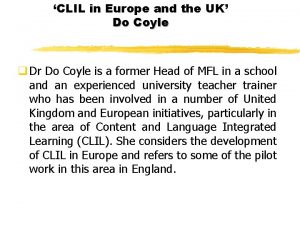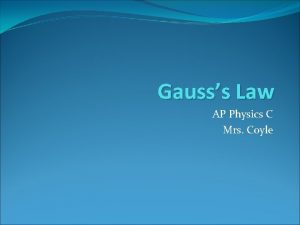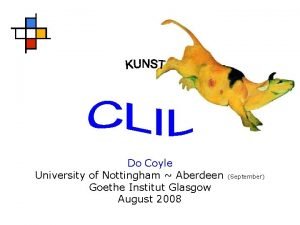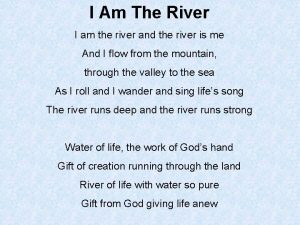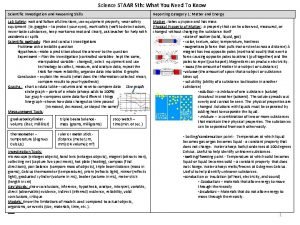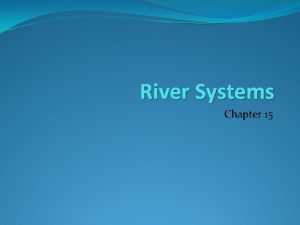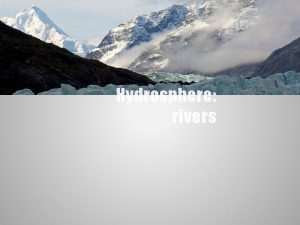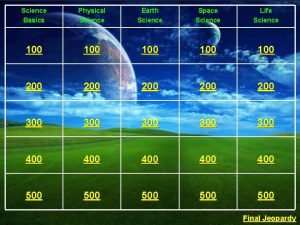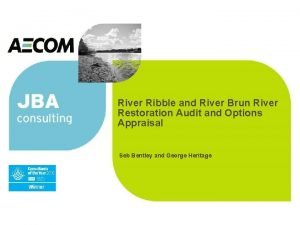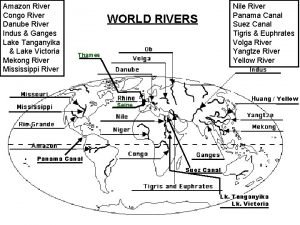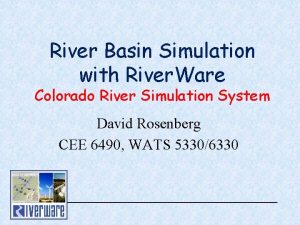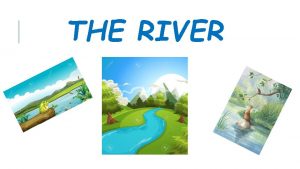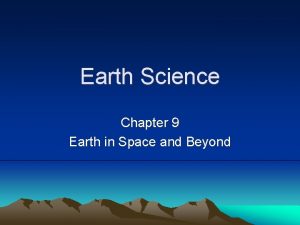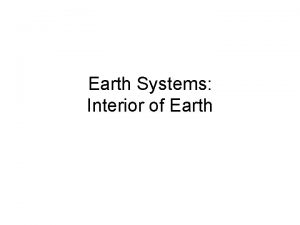River Systems Earth Space Science Mr Coyle The




















































- Slides: 52

River Systems Earth Space Science Mr. Coyle

The Hydrologic Cycle • Infiltration = Groundwater System • Runoff = Surface Water System • Runoff = Precipitation - Evapotranspiration

Where is the Water ?

RIVERS & STREAMS • • • Water Reservoirs The Hydrologic Cycle Surface Water Systems Meandering Deltas/Alluvial Fans Floods and flooding

Importance of rivers • Rivers: – – – Provide water and nutrients for agriculture Provide habitat to diverse flora and fauna Provide routes for commerce Provide recreation Provide electricity www. aquatic. uoguelph. ca/rivers/chintro. htm

Natural Watercourses • Discharge- volume of water • Velocity- rate of water movement • Gradient- slope of inclined surface

Variation in time and space • The shape, size and content of a river are constantly changing, forming a close and mutual interdependence between the river and the land it traverses.

What is a Watershed? www. dec. state. ny. us/website/2000/watersheds. gif www. aquatic. uoguelph. ca/rivers/chwater. htm www. epa. gov/watertrain/ecology 21. html

The Worlds Largest Rivers


U. S. Precipitation Map Notice the effect of the Rocky Mountains U. S. Runoff Map

Laminar vs. Turbulent Flow

Near-Laminar flow in the center of a river channel Turbulent flow in the headwaters of a rushing mountain stream

So Where Does The Stream Move Fastest? • Headwaters move slowest • Mouth of stream moves fastest • Laminar flow is more efficient than turbulent flow. • Deeper stream move faster than shallow streams

Sediment Load

Movement of Bedload by Saltation

Sedimentation

Longitudinal Stream Profile Can be divided into 3 main parts Drainage (Tributary) Transport System Distributary System

Drainage System • Stream energy is spent eroding downward into the basement rock and. . . • Moving sediment • Creates “V” shaped canyon and valleys • When streams emerge from the mountain front, they often deposit some of this sediment forming alluvial fans.

Alluvial Fans Transition from Tributary to Transport

Aging Rivers: How Old Is It? • Young- rapid bed erosion, waterfalls, rapids, v-shaped valleys, few tributaries, low volume • Mature- well established tributaries, larger volume of water, erode banks and not the bed (bottom), meanders, oxbow lakes

Flash Flooding & Sheetwash


Braided Pattern = high slope + high stream power + coarse bed materials

Braided Streams & Rivers • High sediment load • Constantly changing course • Floodplain is completely occupied by channels • Many small islands called mid-channel bars • Usually coarse sand gravel deposits.

Meandering Rivers

Meandering Rivers • • Constantly erode material - Cut bank Constantly deposit material - Point bar Change their channel course gradually Create floodplains wider than the channel – Very Fertile soil – Subjected to seasonal flooding

Formation of Meanders

Point bar deposits

Point Bar Deposits Point bar deposits grows laterally through time

Cut bank erosion Point bar deposits } Meander loop

Formation of an Oxbow


Meandering stream flowing from top of screen to bottom

Maximum deposition Maximum erosion










Meander scars Oxbow Lake Oxbow cuttoff

1993 Mississippi Flood

Flooding & Sedimentation


Deltas - Distribution Systems


If the Mississippi changes course again, what will happen to the City of New Orleans?

Things to Remember • • Rivers are part of a larger hydrologic system The have three main components: Drainage (Tributary) systems - collect water Transport Systems - move water along – Alluvial fans, braided streams, meandering streams • Rivers exceed their capacity during floods • Distributary systems - return water to the sea – Deltas.
 Earthology definition
Earthology definition Describe your favourite subject
Describe your favourite subject Metodo del codo
Metodo del codo Coyle method
Coyle method Coyle and castello method
Coyle and castello method Caitlin coyle
Caitlin coyle Do coyle clil
Do coyle clil Coyle bernard
Coyle bernard Coyle
Coyle Coyle health and wellbeing
Coyle health and wellbeing Coyle electric
Coyle electric Aaron coyle
Aaron coyle University of nottingham
University of nottingham Dr christine coyle
Dr christine coyle Green river (duwamish river tributary)
Green river (duwamish river tributary) I am the river and the river is me
I am the river and the river is me A large crack in the earth formed by a river or earthquakes
A large crack in the earth formed by a river or earthquakes 8th grade science staar review reporting category 4
8th grade science staar review reporting category 4 Arsitektur komunikasi satelit
Arsitektur komunikasi satelit This insulates our earth from the deep cold of space
This insulates our earth from the deep cold of space Earth's role as a body in space
Earth's role as a body in space Earth from space art
Earth from space art Chapter 2 the earth in space answers
Chapter 2 the earth in space answers Chapter 15 river systems answers
Chapter 15 river systems answers River systems nsw
River systems nsw Black river systems
Black river systems Cartesian space trajectory planning
Cartesian space trajectory planning Space junk the space age began
Space junk the space age began Camera space to world space
Camera space to world space Cartesian space vs joint space
Cartesian space vs joint space World space computer
World space computer Hình ảnh bộ gõ cơ thể búng tay
Hình ảnh bộ gõ cơ thể búng tay Frameset trong html5
Frameset trong html5 Bổ thể
Bổ thể Tỉ lệ cơ thể trẻ em
Tỉ lệ cơ thể trẻ em Gấu đi như thế nào
Gấu đi như thế nào Chụp tư thế worms-breton
Chụp tư thế worms-breton Chúa sống lại
Chúa sống lại Các môn thể thao bắt đầu bằng từ đua
Các môn thể thao bắt đầu bằng từ đua Thế nào là hệ số cao nhất
Thế nào là hệ số cao nhất Các châu lục và đại dương trên thế giới
Các châu lục và đại dương trên thế giới Công thức tiính động năng
Công thức tiính động năng Trời xanh đây là của chúng ta thể thơ
Trời xanh đây là của chúng ta thể thơ Cách giải mật thư tọa độ
Cách giải mật thư tọa độ Làm thế nào để 102-1=99
Làm thế nào để 102-1=99 Phản ứng thế ankan
Phản ứng thế ankan Các châu lục và đại dương trên thế giới
Các châu lục và đại dương trên thế giới Thể thơ truyền thống
Thể thơ truyền thống Quá trình desamine hóa có thể tạo ra
Quá trình desamine hóa có thể tạo ra Một số thể thơ truyền thống
Một số thể thơ truyền thống Bàn tay mà dây bẩn
Bàn tay mà dây bẩn Vẽ hình chiếu vuông góc của vật thể sau
Vẽ hình chiếu vuông góc của vật thể sau Nguyên nhân của sự mỏi cơ sinh 8
Nguyên nhân của sự mỏi cơ sinh 8
